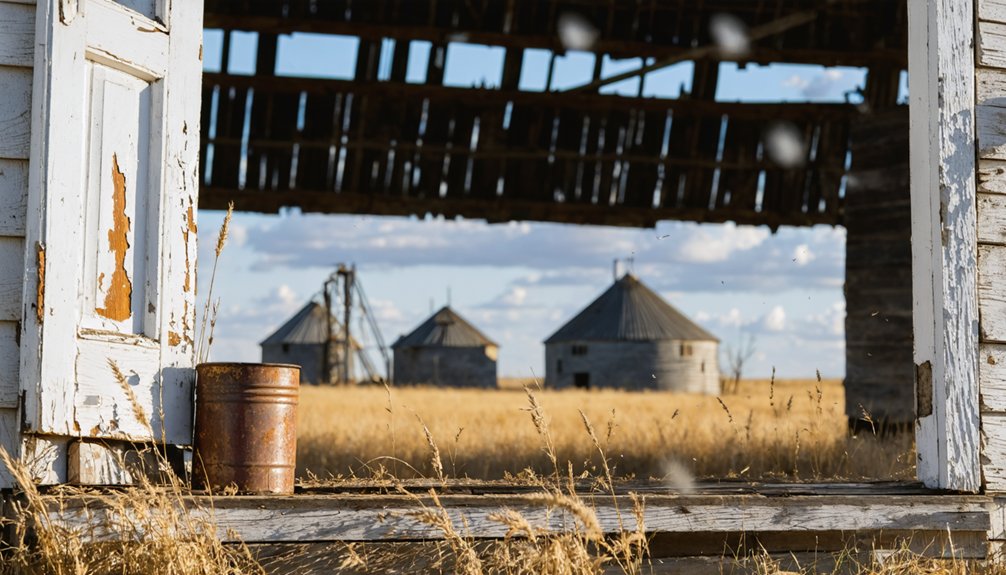You won’t find a ghost town called Queen Bee in South Dakota, but you’ll discover the impressive ruins of the Queen Bee Mill in Sioux Falls’ Falls Park. Built in 1879 for nearly half a million dollars, this seven-story quartzite flour mill operated sporadically until 1929, struggling with unreliable water power before switching to electricity in 1911. After a 1956 fire, only the weathered stone base remains, now preserved as a National Historic Place that holds fascinating tales of industrial ambition.
Key Takeaways
- Queen Bee was not a ghost town, but rather a historic mill site located in Sioux Falls, South Dakota.
- The Queen Bee Mill was built in 1879 and stood seven stories tall, constructed of local quartzite stone.
- Financial struggles and unreliable water power led to the mill’s first closure in 1883, just a few years after opening.
- Though revived with electric power in 1911, the mill permanently ceased operations in 1929.
- A 1956 fire destroyed most of the structure, leaving only ruins that are now preserved in Falls Park.
The Birth of an Industrial Dream
In 1879, Richard F. Pettigrew, South Dakota’s first U.S. senator, launched an ambitious vision to transform the local economy at the Falls of the Big Sioux River. Rather than shipping Dakota’s spring wheat to Minnesota for processing, he planned to mill it right where it grew, creating a powerful community impact through local industry.
You can trace Pettigrew’s determination through his masterful securing of eastern investment, particularly from New York banker George I. Seney. Legend says he convinced Seney by breaking a dam upstream to demonstrate the river’s potential power. Together, they raised nearly half a million dollars and purchased 81 acres for $40,000.
Construction began in August 1879 under J.W. McKeen’s expertise, resulting in a massive seven-story quartzite structure rising 104 feet tall. The mill employed a state-of-the-art 800 horsepower turbine system. By October 1881, the Queen Bee Mill stood ready to harness the river’s power, promising to process 1,200 barrels of flour daily.
Engineering Marvel at the Falls
Rising majestically above the Big Sioux River, the Queen Bee Mill showcased engineering innovations that pushed the boundaries of frontier industrial construction.
Standing seven stories tall, the massive quartzite structure incorporated cutting-edge engineering techniques of its time. You’ll find evidence of J.W. McKeen’s brilliant design in every aspect, from the robust foundation to the intricate power transmission system. The mill’s impressive construction utilized local quartzite stone, reflecting the resourceful use of regional materials.
The mill’s most impressive feature was its 800-horsepower water turbine system, fed by a seven-foot diameter iron pipe from the river. This revolutionary setup powered complex machinery throughout the facility’s 104-foot frame. With its impressive 1,200 barrel daily production capacity, the mill represented the pinnacle of industrial achievement for its era.
The structural integrity of the building supported heavy milling equipment while housing multiple operations – from grain storage to flour production – all integrated with nearby rail systems for maximum efficiency.
Waterpower and Wheat: The Mill’s Design
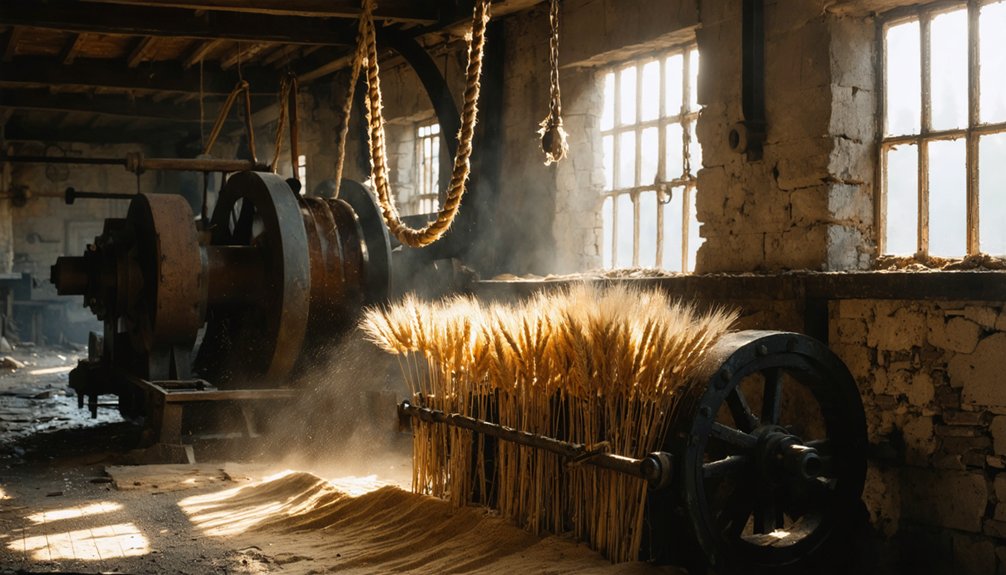
At the most powerful point of the Big Sioux River Falls, you’ll find an ambitious waterpower system designed to harness 800 horsepower through a 7-foot iron tube feeding into the mill’s main turbine.
You can trace how the engineering team connected this massive turbine to the grinding machinery using miles of belts and pulleys, creating what was then considered the most impressive waterpower installation west of the Mississippi.
The strategic location allowed the mill to process up to 1,200 barrels of local Dakota spring wheat daily while minimizing transportation costs from surrounding agricultural regions. The mill’s six-foot thick walls provided structural support for the seven floors of heavy machinery inside.
Turbine Power System Design
While the Big Sioux River promised abundant waterpower for the Queen Bee Mill’s operations, its turbine system represented a sophisticated feat of 19th-century engineering.
J.W. McKeen designed a complex water intake system that channeled the river’s flow through a twelve-foot-deep canal into a seven-foot-diameter tube feeding the turbine.
You’ll find the turbine efficiency was meant to be maximized by the mill’s strategic location at the falls’ most powerful point. The system included a carefully engineered canal, stone turbine housing, and water delivery mechanism designed to power large grinding machinery.
Despite the robust design and durable construction using flood-resistant materials, the Big Sioux’s irregular flow proved insufficient to consistently drive the mill’s ambitious operations, ultimately contributing to its closure by 1885. The mill’s structure was built using locally quarried quartzite to ensure longevity and durability against the elements.
Sioux River Water Management
Despite ambitious engineering plans, the Big Sioux River proved an unreliable power source for the Queen Bee Mill’s operations.
You’ll find that developers constructed an earthen dam from the east bank to a nearby island, along with a 12-foot-deep canal system to channel the river flow to the mill’s turbines.
While the dam and water management structures were designed to maximize power from the falls, they couldn’t overcome the river’s natural challenges.
The Big Sioux’s seasonal variations created frustrating cycles of surges and low periods.
These struggles with water power ultimately led to the mill’s shutdown in 1883.
Even though the system withstood the massive flood of April 1881, the worst in Sioux Falls history, the irregular river flow continued to plague operations.
The mill’s sophisticated water management infrastructure simply couldn’t guarantee the consistent power needed for year-round milling.
Strategic Falls Location Benefits
The strategic placement of Queen Bee Mill on the banks of the Big Sioux River harnessed the Falls’ most powerful point, maximizing its natural energy potential.
You’ll find the impressive seven-story structure, built from locally quarried quartzite, rising 104 feet into the sky on its carefully selected 81-acre site.
The mill’s design revolutionized the local community’s economic impact. Its 800-horsepower water turbine, fed by a 7-foot iron tube from the Falls, powered machinery capable of producing 1,200 barrels of flour daily.
You’re looking at what experts called “the most ambitious attempt to use waterpower west of the Mississippi River.”
The complex included a grain elevator, warehouse, and railroad siding, creating a complete wheat processing facility that transformed the region’s agricultural industry by eliminating costly transport to Minnesota.
Early Triumphs and Tribulations
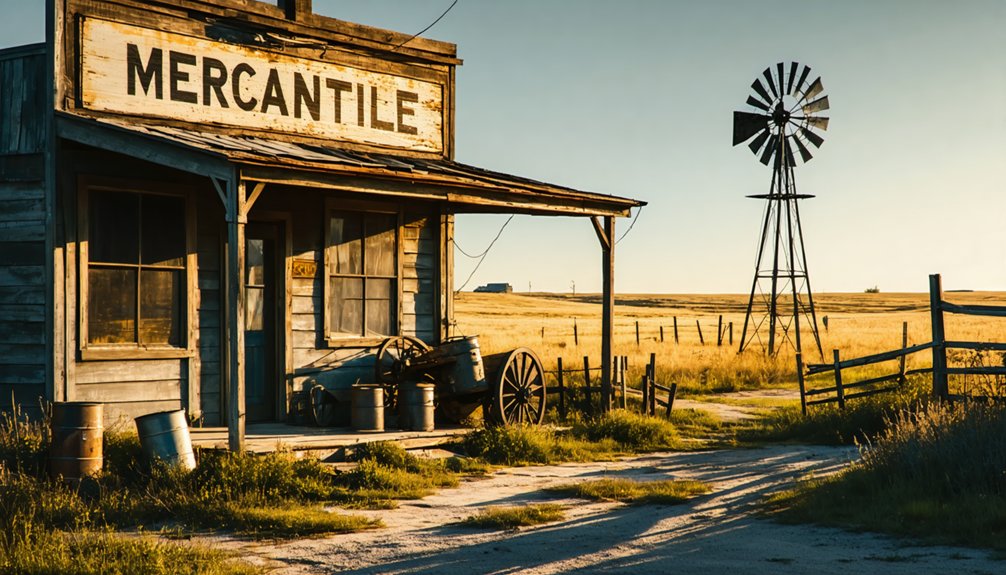
In 1879, you’d have witnessed the massive Queen Bee Mill taking shape at Sioux Falls’ Big Sioux River Falls, where New York financier George Seney’s investment fueled construction of what aimed to be the largest flour mill west of the Mississippi.
By October 1881, your hopes for the mill’s success would’ve been tested as the Big Sioux River proved inadequate to power the facility’s ambitious machinery, despite its innovative canal and turbine system.
Your investment in the Queen Bee would’ve turned sour by 1885, when insufficient water power and regional wheat scarcity pushed the operation into bankruptcy, owing creditors $97,000.
Construction Scale and Ambition
Standing proudly on the banks of the Big Sioux River, Queen Bee Mill emerged from an ambitious $38,000 land acquisition in August 1879.
You’d have witnessed the transformation of an 81-acre site into a massive industrial complex, where 100 workers labored for two years to construct what would become the finest flour mill west of the Mississippi.
Under J.W. McKeen’s supervision, the seven-story structure soared 104 feet high, spanning 80 feet wide and 100 feet long.
The workforce quarried local quartzite for the main building while tackling construction challenges across the complex, including a grain elevator, warehouse, and railroad siding.
The half-million-dollar investment backed by New York banker George I. Seney reflected the era’s bold industrial aspirations, aiming to harness 800 horsepower from the river’s flow.
Water Power Dream Fails
Despite its grand engineering ambitions, Queen Bee Mill‘s waterpower dream came crashing down merely 18 months after opening in October 1881.
You’d think the Big Sioux River would provide enough power for the mill’s massive 800-horsepower turbine, but water resource management proved far more challenging than expected.
The mill’s developers had envisioned producing 1,200 barrels of flour daily, making it the most ambitious waterpower project west of the Mississippi.
Built with quartzite quarried directly from the site, the imposing seven-story mill stood as a testament to industrial innovation.
Instead, they faced constant industrial energy challenges from insufficient water flow and seasonal river variations.
By April 1883, operations ceased entirely.
While later owners attempted to revive the mill with electric power between 1911 and 1929, it never achieved its promised potential.
The mill’s final chapter as a grain warehouse ended dramatically in 1956 when fire destroyed the structure.
The site later found new purpose when Northern States Power donated the hydroelectric plant property to the city in 1974.
Early Investors Face Loss
The ambitious Queen Bee Mill project first attracted major investors in 1879, when Richard F. Pettigrew convinced prominent figures like Colonel James H. Drake and George Seney to invest.
You’ll find that their initial investor miscalculations led to devastating financial repercussions, as they poured $40,000 into 40 acres of land and substantial construction costs.
- The mill’s opening in 1881 quickly revealed critical flaws in their planning.
- By 1885, crushing debt of $97,000 overwhelmed operations.
- Investors discovered the Big Sioux River couldn’t provide reliable power.
- High-grade wheat scarcity made profitable milling impossible.
The enterprise’s downfall stemmed from eastern investors’ misplaced optimism about water power potential and wheat availability.
Despite attempts to salvage operations, including a brief revival with electrical power in 1911, the original investors never recovered their losses, and the mill ultimately closed after World War I.
The Rise and Fall of Queen Bee Operations
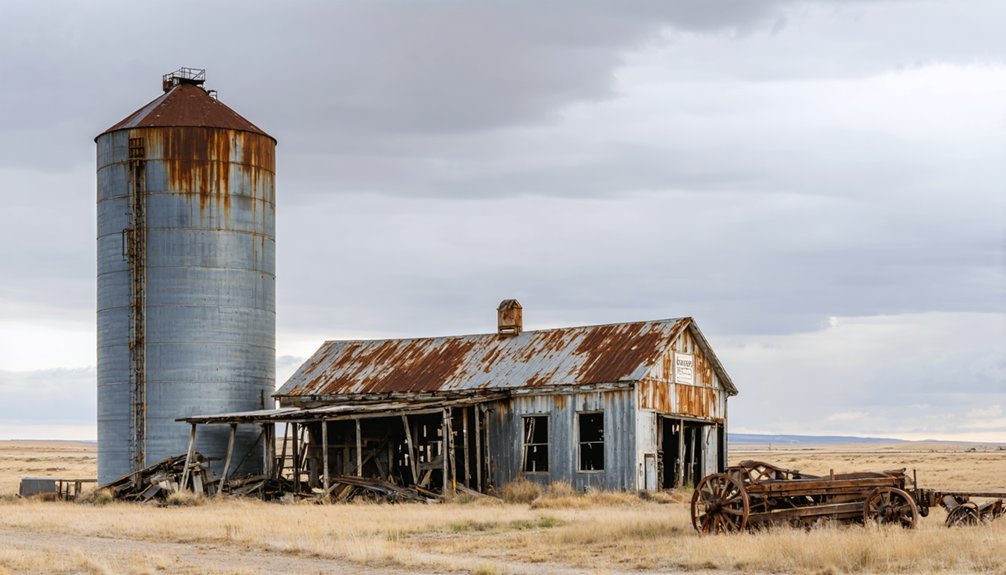
While local entrepreneurs sought economic independence from Minnesota mills, construction of the Queen Bee Mill began in August 1879 under Richard F. Pettigrew‘s leadership. The community engagement resulted in a 40-acre development that included the mill, grain elevator, warehouse, and cooper’s shop. The project’s historical significance drew New York investor George Seney’s financial backing.
You’ll find that operations launched on October 25, 1881, but troubles quickly emerged. The Big Sioux River‘s unreliable flow couldn’t adequately power the mill’s turbines, and a devastating flood in April 1881 highlighted environmental vulnerabilities.
From Water to Electric Power: A Second Life
After struggling with unreliable water power for years, Queen Bee Mill underwent a significant transformation in 1911 when operators replaced its traditional water-driven turbines with modern electric power systems. The installation of electric machinery marked a new era of operational reliability for the mill, freeing it from the Big Sioux River’s inconsistent flow.
- Electric power enabled steady operations until 1918, a notable improvement over the water-powered system that failed in 1883.
- The mill’s complex adapted its existing infrastructure to accommodate the new power source while maintaining its grain elevator and railroad connections.
- This modernization aligned with Sioux Falls’ broader industrial evolution and urban electrification movement.
Despite improved reliability, the mill eventually closed and shifted to warehouse use in 1929, until fire damage led to its demolition in 1956.
The Final Days of a Pioneer Monument
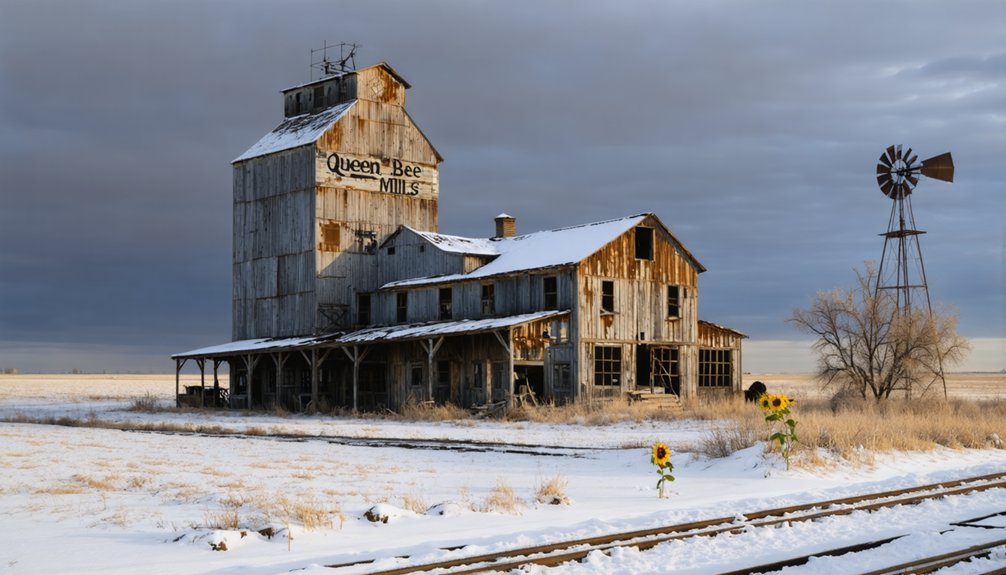
Despite its ambitious origins as a state-of-the-art milling facility, Queen Bee Mill‘s operations steadily declined through the early 1900s until milling ceased completely in 1929.
The economic decline reflected broader shifts as railroads made it cheaper to ship wheat to larger, more established mills in Minnesota.
You’ll find that the building stood unused for decades until a devastating fire in 1956 left only the quartzite base of the once-towering seven-story structure.
The community impact lives on through the mill’s ruins at Falls Park.
After demolition in 1961, the site evolved into a pioneer monument, earning recognition on the National Register of Historic Places in 1984.
Today, you can explore interpretive markers that tell the story of Sioux Falls’ early industrial ambitions through the ghostly remains of Queen Bee Mill.
Preserving the Legacy of Queen Bee
Throughout the decades since its decline, preservation efforts have transformed Queen Bee Mill from abandoned ruins into a protected historical landmark.
You’ll find the site carefully managed within Falls Park, where a protective fence guards the remaining stone walls and foundations. Historical preservation initiatives have focused on maintaining these structural remnants while promoting community engagement through various programs.
- Local historians document the mill’s legacy through publications and research
- School groups and historical societies integrate the site into educational curricula
- Walking tours and public lectures keep the mill’s story alive for visitors
- Interpretive signage and online resources share the site’s significance
Despite conservation challenges and limited funding, the Queen Bee Mill continues to stand as a powerful symbol of Sioux Falls’ industrial heritage and pioneering spirit.
Through careful stewardship, you’re able to experience this representation of early American entrepreneurship firsthand.
Frequently Asked Questions
What Was the Average Daily Wage for Workers at Queen Bee Mill?
You’d find average wages at Queen Bee Mill ranged from $1.00 to $2.50 per day in 1881-1883, with worker conditions varying based on skill level and the mill’s unstable financial situation.
How Many Employees Worked at the Queen Bee Mill During Peak Operations?
From massive turbines to tiny flour barrels, you’d find 100 men working at peak workforce during the early 1880s, spread across the mill operations including the main structure, grain elevator, and cooper’s shop.
Were There Any Deaths or Serious Accidents During the Mill’s Construction?
While construction hazards existed during the mill’s challenging two-year build, you won’t find documented evidence of any deaths or serious mill accidents in historical records from 1879-1881.
What Happened to the Mill’s Equipment After Its Initial Closure?
You’ll find the original equipment stayed largely untouched after the 1885 closure, deteriorating through sporadic usage until the 1956 fire destroyed everything, leaving only historical significance in the quartzite ruins.
Did Any Other Businesses Operate in Queen Bee Besides the Mill?
You’ll find several businesses operated alongside the mill: a grain elevator, warehouse, cooper’s shop, and railroad facilities supported local commerce, though records don’t indicate other major community events or enterprises.
References
- https://www.sdhspress.com/journal/south-dakota-history-28-4/the-queen-bee-mill-legend-did-pettigrew-trick-the-eastern-investors/vol-28-no-4-the-queen-bee-mill-legend.pdf
- https://www.localloupodcast.com/episodes-of-local-lou/the-queen-bee-mill
- https://www.argusleader.com/story/life/2016/06/03/looking-back-queen-bee-mill-remains-remind-us-once-imposing-structure/85291944/
- https://www.sdpb.org/rural-life-and-history/History-of-the-Queen-Bee-Mill-in-Sioux-Falls
- https://www.gpsmycity.com/attractions/queen-bee-mill-63981.html
- https://www.hmdb.org/m.asp?m=124190
- https://en.wikipedia.org/wiki/List_of_ghost_towns_in_South_Dakota
- https://www.hmdb.org/m.asp?m=124251
- https://lostinsiouxland.wordpress.com/2021/03/20/learning-history-in-siouxland-queen-bee-mill-sioux-falls-sd/
- http://siouxfallshistoricsites.blogspot.com/2006/04/queen-bee-mill.html
